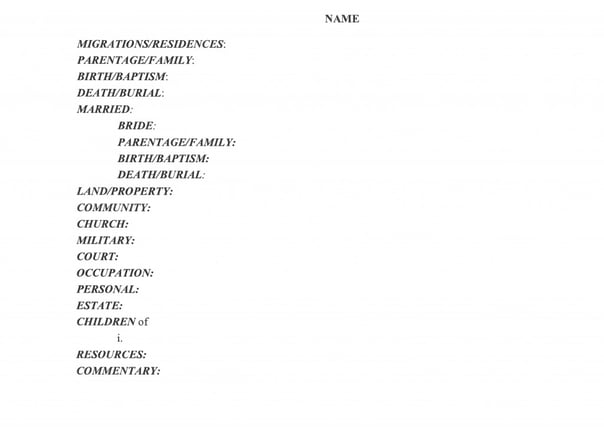 In a recent post I mentioned the Early New England Families Study Project “template” that I use: a Word document file with the categories pre-typed. I keep it on my desktop to open and “save as” the new file name each time I start a new family. For those of you who are knowledgeable about Word template files, you can set it up as such. As I do the research, I dump all the raw material into the form, then whittle it down as I proof, compare, and refine the text.
In a recent post I mentioned the Early New England Families Study Project “template” that I use: a Word document file with the categories pre-typed. I keep it on my desktop to open and “save as” the new file name each time I start a new family. For those of you who are knowledgeable about Word template files, you can set it up as such. As I do the research, I dump all the raw material into the form, then whittle it down as I proof, compare, and refine the text.
The first five steps were covered in the last post:
1. Review the Great Migration Study Project database (GM).
2. Review the Great Migration Newsletter (GMN).
3. Review Torrey’s Marriages (TM).
4. Create a Blocking Draft (BD).
5. Begin creating Research piles (RP).
and
6. Undertake a New Print Search (NPS) – see another, earlier post on this topic.
7. Thorough Periodical Search (TPS). Depending on what I have already searched, I go back to the “Journals and Periodicals” category on AmericanAncestors.org and search “all” databases. I may also go to the National Genealogical Society at ngsgenealogy.org where I have member access to the National Genealogical Society Quarterly back issues and index. I might also go to the hathitrust.org, about which I’ve written before, and possibly jstor.org if I am looking for historical studies about a particular time and place.
8. Colony Records and Histories (Colony). I have downloaded my own collection of these often overlooked but extremely valuable sources of seventeenth-century material, including Records of the Governor and Company of the Massachusetts Bay in New England, 1628-1686, Records of the Colony of New Plymouth in New England, The Public Records of the Colony of Connecticut, 1636-1776, Provincial Papers, Documents and Records Relating to the Province of New Hampshire from 1686 to 1722, and History of the State of Rhode Island and Providence Plantations, Vol. I 1636-1700. For sources such as these that I use frequently, every time I access an index page, I print it, then collect all the pages as a hard copy index, which I can annotate.
9. Vital Records (VR). Beginning with the “Vital Records (incl. Bible, Cemetery, Church, and SSDI)” category on AmericanAncestors.org, I’ll search all the relevant places in our comprehensive collection of Massachusetts, Rhode Island, and Connecticut records – including some manuscript vital records for unpublished towns (such as Hingham). For early Maine and New Hampshire VR, I go to Familysearch.org. If I want to see an original page of Massachusetts records, Familysearch has a browsable version of Massachusetts, Town and Vital Records, 1620-1988, but I have to go over to Ancestry.com for an indexed version.
The series continues here.
Share this:

About Alicia Crane Williams
Alicia Crane Williams, FASG, Lead Genealogist of Early Families of New England Study Project, has compiled and edited numerous important genealogical publications including The Mayflower Descendant and the Alden Family “Silver Book” Five Generations project of the Mayflower Society. Most recently, she is the author of the 2017 edition of The Babson Genealogy, 1606-2017, Descendants of Thomas and Isabel Babson who first arrived in Salem, Massachusetts, in 1637. Alicia has served as Historian of the Massachusetts Society of Mayflower Descendants, Assistant Historian General at the General Society of Mayflower Descendants, and as Genealogist of the Alden Kindred of America. She earned a bachelor’s degree from the University of Connecticut and a master’s degree in History from Northeastern University.View all posts by Alicia Crane Williams →
